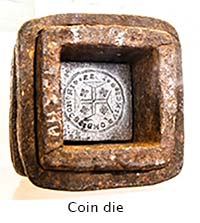Hebden Bridge Local History Society
The Yorkshire coiners in 2022
Revisiting the Yellow Trade
Speaker: John Styles
Tuesday, 6 December 2022
During 2021, Heptonstall and the surrounding areas were excited by the filming of Benjamin Myers' novel The Gallows Pole, briefed as a gothic noir version of the story of the Yorkshire coiners. One of the historical advisors to the film makers was John Styles, Professor Emeritus at the University of Hertfordshire, who wrote about the coiners – Our traitorous money makers – about 30 years ago, and who visited Hebden Bridge Local History Society to consider how time has changed the ways in which we look at the 'yellow trade' of counterfeit money making.
Some historians have characterised the coiners as fighting a revolutionary battle against capitalism, while others have been drawn to a rather romantic view of the outlaw men up in the hills creating gold coins. For John Styles, the yellow trade was essentially a well organised business, with entrepreneurs seizing on the opportunities offered by an already debased coinage and a consequent shortage of cash. The use of 'yellow trade' to describe the traitorous occupation mirrored names such as kersey trade and worsted trade, suggesting a degree of legitimacy.
 John was clear that there was a very specific type of coining in the 1760s that was distinctively Yorkshire, and confined to the valleys around Halifax, encompassing Rochdale and Keighley. This was a totally different model to the earlier coiners who used base metals to mint coins which were then passed off as gold. The Yorkshire coiners used clippings from genuine gold coins, so that the counterfeits gradually became accepted as valid. Genuine gold guineas could sometimes lose 5% of their value through wear, and an influx of Portuguese gold coins, whose face value exceeded the value of the gold, provided a source for gold to be clipped. The new coins had enough intrinsic value to be acceptable, and importantly, they met a need.
John was clear that there was a very specific type of coining in the 1760s that was distinctively Yorkshire, and confined to the valleys around Halifax, encompassing Rochdale and Keighley. This was a totally different model to the earlier coiners who used base metals to mint coins which were then passed off as gold. The Yorkshire coiners used clippings from genuine gold coins, so that the counterfeits gradually became accepted as valid. Genuine gold guineas could sometimes lose 5% of their value through wear, and an influx of Portuguese gold coins, whose face value exceeded the value of the gold, provided a source for gold to be clipped. The new coins had enough intrinsic value to be acceptable, and importantly, they met a need.
There were considerable risks to the trade, which was a treasonable offence, but there was a very low chance of prosecution, with very few magistrates, and the specialist 'mint solicitor,' whose job was to search out such activities, not paid enough in expenses to do the work. It seems also that the local population tacitly lent their support, so that the coiners' trade was legitimised. Eventually there was a highly organised business, drawing on the business acumen of wool merchants, and their networks who would provide the gold clippings, and distribute the new coins. Many of those accused of coining had textile related occupations, and it seems the yellow trade drew on the existing structures of the early textile industry, with access to capital through local credit.
Central to the coiners local to the Cragg Vale area – known then as the Turviners or the Upper Hand – was David Hartley, whose activities were based at Bell House. In local legend he was seen as 'King' David, who saved people from poverty. Fiction prefers the romantic, albeit violent, version of the story. For John Styles the coiners trade was a version of opportunistic capitalism, rather than a Robin Hood story. In the end the trade of the coiners was not defeated by prosecution and deterrent punishments, but by a wholesale re-coinage in 1773 which rendered clipped coins unacceptable.
The next meeting of Hebden Bridge Local History Society is on Wednesday 14th December at Hebden Royd Methodist Church with a 7.30 start. Richard Rainbow will be talking about Calder Valley Naturalists and their struggles.
Details of the History Society talks programme, publications and of archive opening times are available on the History website and you can also follow History Society Facebook page.
With thanks to Sheila Graham for this report
See also: the HebWeb History section

